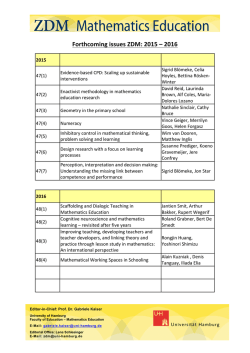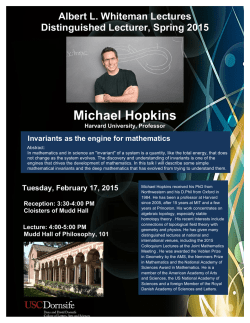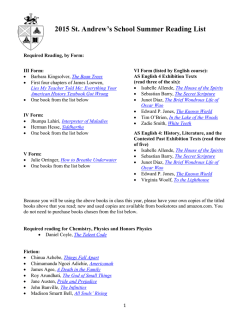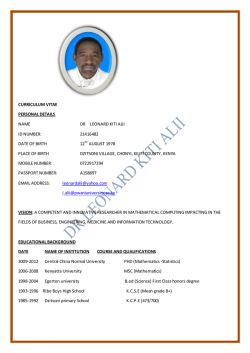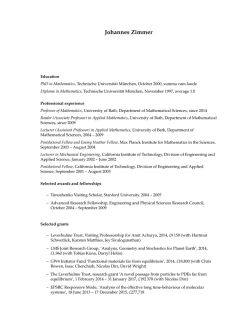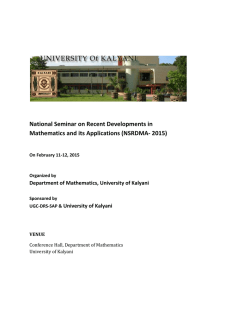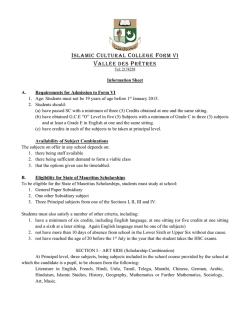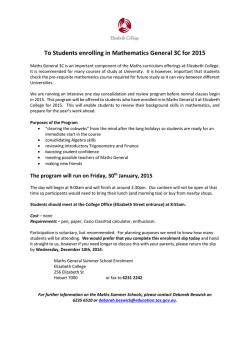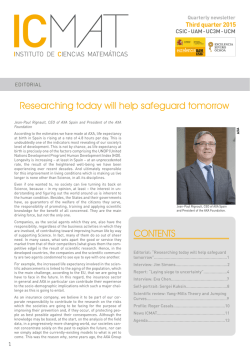
Ethnomathematics: the cultural aspects of mathematics
Rosa, M. & Orey, D. C. (2011). Ethnomathematics: the cultural aspects of mathematics. Revista Latinoamericana de Etnomatemática, 4(2). 32-54 Artículo recibido el 28 de mayo de 2011; Aceptado para publicación el 16 de junio de 2011 Ethnomathematics: the cultural aspects of mathematics Etnomatemática: os aspectos culturais da matemática Milton Rosa1 Daniel Clark Orey2 Abstract Ethnomathematics studies the cultural aspects of mathematics. It presents mathematical concepts of the school curriculum in a way in which these concepts are related to the students’ cultural and daily experiences, thereby enhancing their abilities to elaborate meaningful connections and deepening their understanding of mathematics. Ethnomathematical approaches to mathematics curriculum are intended to make school mathematics more relevant and meaningful for students and to promote the overall quality of their education. In this context, the implementation of an ethnomathematical perspective in the school mathematics curriculum helps to develop students’ intellectual, social, emotional, and political learning by using their own unique cultural referents to impart their knowledge, skills, and attitudes. This kind of curriculum provides ways for students to maintain their identity while succeeding academically. Keywords: Ethnomathematics, Culture, Mathematics Curriculum, Sociocultural Contexts, Informal Mathematics, Academic Mathematics. Resumo A etnomatemática estuda os aspectos culturais da matemática. Apresenta os conceitos matemáticos do currículo escolar de uma maneira na qual esses conceitos estejam relacionados com as experiências cultural e diária dos alunos, reforçando, assim, a capacidade deles para elaborar conexões significativas e aprofundar o entendimento da matemática. A abordagem etnomatemática no currículo de matemática tem como objectivos tornar a matemática escolar mais relevante e significativa para os alunos, promovendo a qualidade geral da educação. Nesse contexto, a implementação da perspectiva etnomatemática no currículo escolar de matemática auxilia no desenvolvimento do aprendizado intelectual, social, emocional e político dos alunos ao utilizar as próprias referencias culturais para transmitir o conhecimento, as habilidades e as atitudes. Esse tipo de curriculo fornece maneiras pelas quais os alunos mantém a própria identidade enquanto são bem sucedidos academicamente. Palavras-chave: Etnomatemática, Cultura, Currículo Etnomatemático, Contextos Socioculturais, Matemática Informal, Matemática Acadêmica 1 Doutor em Educação, Liderança Educacional, pela California State University, Sacramento. Professor e pesquisador em Educação Matemática no Centro de Educação Aberta e à Distância (CEAD), na Universidade Federal de Ouro Preto (UFOP) em Ouro Preto, Minas Gerais, Brasil. Email: [email protected] 2 Doutor em Educação e Educação Multicultural, pela University of New Mexico. Professor e pesquisador em Educação Matemática no Centro de Educação Aberta e à Distância (CEAD), na Universidade Federal de Ouro Preto (UFOP) em Ouro Preto, Minas Gerais, Brasil. Email: [email protected] 32 Revista Latinoamericana de Etnomatemática Vol. 4 No. 2, agosto de 2010- enero de 2011 Introduction An important change in mathematical instruction needs to take place in order to accommodate continuous and ongoing change in the demographics of students in mathematics classrooms. Some scholars have developed a theory of culturally relevant pedagogy that examines the teaching-learning process within a critical paradigm and through explicit connections between students’ culture and the school subject matter (D’Ambrosio, 1990; Gay, 2000; Ladson-Billings, 1995; Rosa & Orey, 2003). In this perspective, it is necessary to integrate a culturally relevant curriculum in the existing mathematics curriculum. According to Torres-Velasquez and Lobo (2004), this perspective is an essential component of culturally relevant education because it proposes that teachers contextualize mathematics learning by relating mathematical content to students’ culture and real-life experiences. The guidelines of the National Council of Teacher of Mathematics (NCTM, 1991) highlighted the importance of building connections between mathematics and students’ personal lives and cultures. In accordance to this approach, Rosa and Orey (2006) affirmed that “When practical or culturally-based problems are examined in a proper social context, the practical mathematics of social groups is not trivial because they reflect themes that are profoundly linked to the daily lives of students” (p. 34). According to Rosa and Orey (2008), culturally relevant mathematics curriculum should focus on the role of mathematics in a sociocultural context that involves the ideas and concepts associated with ethnomathematics, using an ethnomathematical perspective for solving contextualized problems. This kind of mathematics curriculum examines cultural congruence between students’ community and school, which indicates teachers’ respect for the cultural experiences of their students. According to Zeichner (1996), in order for teachers to implement the principle of cultural congruence, they should have knowledge of and respect for the various cultural traditions and languages of students in their classrooms. In so doing, they should develop a clear sense of their own ethnic and cultural identities to be able to understand and appreciate those of their students in order to perceive mathematics as a socially and 33 Rosa, M. & Orey, D. C. (2011). Ethnomathematics: the cultural aspects of mathematics. Revista Latinoamericana de Etnomatemática, 4(2). 32-54 culturally constructed disciplines (Banks, 1991; Lee, 1999). In so doing, teachers need to comprehend what counts as knowledge in mathematics as well as how knowledge may be related to norms and values of diverse cultures. In other words, dealing with integrating diverse cultures in the classroom needs a conceptual framework in order to make coherent pedagogical decisions as teachers, which may help them understand how their own cultural biases influence judgments about students’ performance and obstruct their ability to learn mathematics. Is Mathematics Acultural? Mathematics was for a long time regarded as a neutral and culturally-free discipline removed from social values (Bishop, 1993; D’Ambrosio, 1990). It was always taught in schools as a culturally free subject that involved learning supposedly universally accepted facts, concepts, and contents. This means that Western or academic mathematics consists of a body of knowledge of facts, algorithms, axioms, and theorems. In this regard, Rosa and Orey (2006) argued that the ethnomathematics program was developed “to confront the taboos that mathematics is a field of study that is universal and acculturated” (p. 20). D’Ambrosio (1990) and Joseph (2000), and Powell and Frankenstein (1997) argued that the pervasive view of mathematics as Eurocentric and value-free misrepresents the evolution of modern mathematics. This perception is also reinforced by students’ experiences of the way mathematics is taught in schools. Brown, Cooney, and Jones (1990) suggested that the teachers’ view of mathematics is transmitted to the students in their instruction, and this fact helps to shape students’ views about the nature of mathematics. Even though the universality of mathematical truths is not in question, Rosa and Orey (2006) affirmed that it is only in the last three decades that the view of mathematics as culture free has been challenged. According to Bishop, Hart, Lerman, and Nunes (1993), “There is no sense in regarding mathematics learning as abstract and culture free” (p. 1) because the learning process cannot be abstract and context free, that is, learning cannot be free of societal influence. For example, studies conducted by Bandeira and Lucena (2004), Chieus (2004) and Rosa and 34 Revista Latinoamericana de Etnomatemática Vol. 4 No. 2, agosto de 2010- enero de 2011 Orey (2009) that examined mathematics in a variety of cultural contexts confirm this assertion. Nasir and Cobb (2007) and Orey (2000) argued that it is worth noting that the contextualization of mathematics has been described as the identification of mathematical practices developed in different cultural groups. In this perspective, if mathematics is considered as a cultural construct, then it is a product of cultural development (Rios, 2000; Rosa & Orey, 2007). This claim of mathematics as a cultural construct contradicts the claims that modern mathematics is universal, objective, and culturally neutral. What is Ethnomathematics? The term ethnomathematics was coined by D’Ambrosio (1985) to describe the mathematical practices of identifiable cultural groups and may be regarded as the study of mathematical ideas found in any culture. D’Ambrosio (1990) defined ethnomathematics in the following way: The prefix ethno is today accepted as a very broad term that refers to the socialcultural context and therefore includes language, jargon, and codes of behavior, myths, and symbols. The derivation of mathema is difficult, but tends to mean to explain, to know, to understand, and to do activities such as ciphering, measuring, classifying, inferring, and modeling. The suffix tics is derived from techné, and has the same root as technique (p. 81). In other words, ethno refers to members of a group within a cultural environment identified by their cultural traditions, codes, symbols, myths, and specific ways used to reason and to infer (Rosa & Orey, 2007). Mathema means to explain and understand the world in order to transcend, manage and cope with reality so that the members of cultural groups can survive and thrive, and tics refer to techniques such as counting, ordering, sorting, measuring, weighing, ciphering, classifying, inferring, and modeling. Rosa and Orey (2003) stated that the mathema develops the tics within the context of ethnos because it consists of daily problems people face, larger problems of humanity, and endeavors of humans to create a meaningful world. According to D’Ambrosio (1990), the search for solutions for specific problems that help the development of mathematics are always imbedded in a cultural context: in order to understand how mathematics (tics) is created, it is necessary to understand the problems 35 Rosa, M. & Orey, D. C. (2011). Ethnomathematics: the cultural aspects of mathematics. Revista Latinoamericana de Etnomatemática, 4(2). 32-54 (mathema) that precipitate it. It is necessary to understand those problems (mathema) by considering the cultural context (ethnos) that drives them. D’Ambrosio (1993) stated that the mission of the ethnomathematics program is to acknowledge that there are different ways of doing mathematics by considering the appropriation of the academic mathematical knowledge developed by different sectors of the society as well as by considering different modes in which different cultures negotiate their mathematical practices. Barton (1996) stated that in this conception, ethnomathematics is a program that investigates the ways in which different cultural groups comprehend, articulate, and apply concepts and practices that can be identified as mathematical practices. Moreover, ethnomathematics may be described as a way in which people from a particular culture use mathematical ideas and concepts for dealing with quantitative, relational, and spatial aspects of their lives (Borba, 1997). This way of viewing mathematics validates and affirms all people's experience of mathematics because it demonstrates that mathematical thinking is inherent to their lives. Further evidence of this assertion is given by Orey (2000), who stated, “The paradigm that diverse cultures use or work within evolves out of unique interactions between their language, culture and environment” (p. 248). Within this context, D’Ambrosio (2006) argued that in an ethnomathematical perspective, mathematical thinking is developed in different cultures in accordance to common problems that are encountered within a cultural context. In D’Ambrosio’s (1993) perspective, in order to solve specific problems, ad hoc3 solutions are created, generalized methods are developed from those solutions to solve similar problems, and theories are developed from these generalized methods. In the context of ethnomathematics, many cultural differentiated groups know mathematics in ways that are quite different from academic mathematics as taught in schools. The tendency has been to 3 Ad hoc is a Latin expression that means for this purpose. It generally means a solution designed for a specific problem or task, non-generalizable, and which cannot be adapted to other purposes. 36 Revista Latinoamericana de Etnomatemática Vol. 4 No. 2, agosto de 2010- enero de 2011 consider these ad hoc mathematical practices as non-systematic and non-theoretical. In contrast, the study of ethnomathematics underlies a structure of inquiry in ad hoc mathematical practices by considering how these practices and problem-solving techniques can be developed into methods and theories. Since different types of problems are common in different cultures, the kinds of solutions, methods, and theories that are developed may differ from culture to culture. In this regard, what is recognized as a problem and a solution in one culture may have no meaning at all in another one. Mathematics is identified in cultural activities in traditional and non-traditional societies (Dowling, 1991; Rosa & Orey, 2007). This means that ethnomathematics refers to mathematical concepts embedded in cultural practices and recognizes that all cultures and all people develop unique methods and sophisticated explications to understand and to transform their own realities (Orey, 2000). It also recognizes that the accumulated methods of these cultures are engaged in a constant, dynamic, and natural process of evolution and growth. D’Ambrosio (2001) stated that ethnomathematics has come to mean the study of how people within various cultural groups develop techniques to explain and understand their world in response to problems, struggles, and endeavors of human survival. This includes material needs as well as art and spirituality through the use of the development of cultural artifacts; objects created by members of a specific cultural group that inherently give cultural clues about the culture of its creator and users. Rosa and Orey (2008) stated that this perspective “provides an important opportunity for educators to link current events and the importance of these artifacts in the context of ethnomathematics, history, and culture” (p. 33). Another presupposition of ethnomathematics is that it validates all forms of mathematical explaining and understanding formulated and accumulated by different cultural groups. This knowledge is regarded as part of an evolutionary process of change that is part of the same cultural dynamism as each cultural group comes into contact with each other one (D’Ambrosio, 1993). A study of the different ways in which peoples resolve problems and the practical algorithms upon which they base these mathematical perspectives becomes relevant for any real comprehension of the concepts and the mathematical they have 37 Rosa, M. & Orey, D. C. (2011). Ethnomathematics: the cultural aspects of mathematics. Revista Latinoamericana de Etnomatemática, 4(2). 32-54 developed over time. Ethnomathematics refers to forms of mathematics that vary as a consequence of being embedded in cultural activities whose purpose is other than doing mathematics. In this perspective, Orey (2000) affirmed, “Ethnomathematics might be characterized as a tool to act in the world” (p. 250) and as such, it provides insights into the social role of academic mathematics. On the other hand, the learning of mathematics has always been associated with the schooling process, that is, it was thought that mathematical concepts and skills were acquired only if individuals went to school. However, the analysis of students’ mathematical knowledge has led educators and researchers to conclude that mathematical knowledge is also acquired outside of the structured systems of mathematics learning such as schools (Bandeira & Lucena, 2004; Duarte, 2004; Knijnik, 1993; Rosa & Orey, 2010). In this perspective, mathematical ideas applied in unique sociocultural contexts refer to the use of mathematical concepts and procedures acquired outside of schools as well as the acquisition of mathematical skills other than from schools. Studies conducted by Bandeira and Lucena (2004) and Lean (1994) focused on school mathematics and the effect of cultural factors on teaching and learning academic mathematics. Dossey (1992) and Orey (2000) argued that mathematical knowledge results from social interactions in which relevant ideas, facts, concepts, principles, and skills are acquired as a result of cultural context. According to Stigler and Baraness (1988), mathematics is not a universal formal domain of knowledge. It is an assemblage of culturally constructed symbolic representations and procedures that facilitate the manipulation of these representations. Students develop representations and procedures into their cognitive systems, which is a process that occurs in the context of socially constructed activities (Rosa & Orey, 2008). In other words, mathematical skills that students learn in schools are not logically constructed based on abstract cognitive structures but rather forged out of a combination of previously acquired knowledge and skills and new cultural inputs. Therefore, D’Ambrosio (1990) affirmed that mathematics arose out of the needs of organized society, which cannot be divorced from the activities and practices developed by people in a globalized society. 38 Revista Latinoamericana de Etnomatemática Vol. 4 No. 2, agosto de 2010- enero de 2011 Informal and Academic Mathematics Carraher (1991) argued that mathematics practices existing out-of-school are shown by students who develop the understanding of numbers before they come to school. Bishop (1993) affirmed that informal mathematics is “an organized, systematic, mathematics education activity carried on outside the framework of the formal system” (p. 15). In this point of view, there is a contrast between the mathematical knowledge gained academically and the mathematical knowledge that is gained informally. For example, Bandeira and Lucena (2004) investigated mathematical ideas and practices acquired by the members of a community of vegetable farmers in the Northeast region of Brazil. They studied the mathematical concepts that farmers used to harvest, produce, and commercialize vegetables. They found out that the specific mathematical knowledge produced by the farmers differed from the mathematical knowledge acquired in academic settings. As a follow-up to a study, which investigated school failure, Carraher (1991) studied young street vendors in the Northeast of Brazil in order to find out about their knowledge of street mathematics such as algorithms when compared to academic school computations. It was found that there were differences in the success rates across the two settings. The results of this study showed that vendors were more successful in correctly solving street contexts and verbal problems but were not so successful in solving traditional and academic computation problems. The procedures for solutions were also different from those taught at school. On the other hand, Nunes (1992) affirmed that even though some of these concepts were acquired without schooling, schooling played an important role in accelerating the learning of these concepts, in particular, inverse proportion and word problems. Carraher, Carraher, and Schleiman (1985) suggested that some important mathematical concepts are developed outside of school without specific instructions because these concepts and procedures would appear to arise through an individual’s social interactions in everyday activities such as commerce and production of goods. Based on Nunes’ (1992) research with Brazilian vendors, it is possible to conclude that mathematical ideas and 39 Rosa, M. & Orey, D. C. (2011). Ethnomathematics: the cultural aspects of mathematics. Revista Latinoamericana de Etnomatemática, 4(2). 32-54 practices that are used outside of the school may be considered as a process of modeling rather than a mere process of manipulation of numbers. In this regard, Orey (2000) stated that the application of “ethnomathematical techniques and the tools of mathematical modeling allows us to see a different reality and give us insight into science done in a different way” (p. 250). In order to solve problems, students need to understand alternative mathematical systems and they also need to be able to understand more about the role that mathematics plays in a societal context (Orey, 2000; Rosa & Orey, 2007). This aspect promotes a better understanding of mathematical systems through the use of mathematical modeling, which is a process of translation and elaboration of problems and questions taken from systems that are part of the students’ own reality (D’Ambrosio, 1993; Eglash, 1997; Rosa & Orey, 2010). As early as 1993, D’Ambrosio defined a system as a part of reality, which is considered integrally. In this regard, a system is a set of items taken from students’ reality, which studies of all its components and the relationship between them. Mathematical modeling is a pedagogical strategy used to motivate students to work on mathematics content and helps them to construct bridges between informal and academic mathematics. For example, D’Ambrosio (2002) commented about an ethnomathematical example that naturally comes across as having a mathematical modeling methodology. In the 1989-1990 school year, a group of Brazilian teachers studied the cultivation of vines that were brought to Southern Brazil by Italian immigrants in the early twentieth century. This was investigated because the cultivation of wines is linked with the culture of the people in that region in Brazil. Both Bassanezi (2002) and D’Ambrosio (2002) believed that this wine case study is an excellent example of the connection between ethnomathematics and mathematical modeling. Rosa and Orey (2010) affirmed that the pedagogical approach that connects the cultural aspects of mathematics with its academic aspects is called ethnomodeling. Educators and teachers should search for problems taken from students’ reality that translate their deepened understanding of real-life situations through the application of 40 Revista Latinoamericana de Etnomatemática Vol. 4 No. 2, agosto de 2010- enero de 2011 culturally relevant activities. This process enables students to take a position such as sociocultural, political, environmental, and economical in relation to the system under study. According to Rosa (2000), the main objective of this pedagogical approach is to rehearse the established mathematical context that allows students to see the world as consisting of opportunities to employ mathematical knowledge that help them to make sense of any given situation. An Ethnomathematics Curriculum Classrooms and learning environments cannot be isolated from the communities in which they are embedded. Classrooms are part of a community with defined cultural practices. In this perspective, Borba (1993) stated that classrooms might be considered environments that facilitate pedagogical practices, which are developed by using an ethnomathematical approach. When students come to school, they bring with them values, norms, and concepts that they have acquired in their sociocultural environment. According to Bishop (1993), some of these are mathematical in nature. However, the mathematical concepts of the school curriculum are presented in a way that may not be related to the students’ cultural backgrounds. Bakalevu (1998) and Rosa (2010) hypothesized that low attainment in mathematics due to lack of cultural consonance in the curriculum. Moreover, Eglash (1997), Rosa & Orey (2007) and Zaslavsky (1997) argued that including cultural aspects in the curriculum will have long-term benefits for mathematics learners, that is, cultural aspects contribute to recognizing mathematics as part of daily life, enhancing the ability to make meaningful connections, and deepening the understanding of mathematics. In this perspective, Chieus (2004) stated that the pedagogical work towards an ethnomathematics perspective allows for a broader analysis of the school context in which pedagogical practices transcend the classroom environment because these practices embrace the sociocultural context of the students. Damazio (2004) agreed with this perspective by suggesting that pedagogical elements necessary to develop the mathematics curriculum are found in the school community. This means that the field of ethnomathematics presents some possibilities for educational initiatives that help to reach this goal. In D’Ambrosio’s 41 Rosa, M. & Orey, D. C. (2011). Ethnomathematics: the cultural aspects of mathematics. Revista Latinoamericana de Etnomatemática, 4(2). 32-54 (1990) point of view, it is important to recognize that ethnomathematics is a research program that guides educational pedagogical practices. However, according to Monteiro, Orey, and Domite (2004), it is necessary to point out that the incorporation of the objectives of the ethnomathematics program as pedagogical practice in the school curricula and its operationalization and transmission in the field of education is a recent field of study that is still developing its own identity in the pedagogical arena. On the other hand, in the context of culturally relevant pedagogy, there is a need to examine the embeddedness of mathematics in culture, drawing from a body of literature that takes on the cultural nature of knowledge production into the mathematics curriculum (Rogoff, 2003). Mathematics as part of the school curriculum must reinforce and value the cultural knowledge of students rather than ignore or negate it. A culturally relevant curriculum should fully integrate students’ cultural mathematics knowledge through ethnomathematics. Rosa and Orey (2007) argued that this mathematics curriculum must be grounded in a constructivist approach to learning and seek to change the way mathematics teachers construct their learning environments. This can be done by producing teachers who are able to facilitate a mathematics learning environment grounded in real life experiences and to support students in the social construction of mathematical knowledge. The trend towards ethnomathematical approaches to mathematics curriculum and pedagogy reflects a comprehensive development in mathematics education. Ethnomathematical approaches are intended to make school mathematics more relevant and meaningful to students and to promote the overall quality of education. Adam (2002) pleaded for a more culturally sensitive view of mathematics to be incorporated into the school curriculum. For example, Powell and Frankenstein (1997) proposed the elaboration of a mathematics curriculum that is based on students’ knowledge, which allows teachers to have more freedom and creativity to choose academic mathematical topics to be covered in the lessons. They suggested that through dialogue with the students, teachers can apply mathematical themes that help them to elaborate the mathematics curriculum. In their point of view, teachers can engage students in the critical analysis of the dominant culture as well as the analysis of their own culture through an ethnomathematical perspective. In this 42 Revista Latinoamericana de Etnomatemática Vol. 4 No. 2, agosto de 2010- enero de 2011 context, Ferreira (1997) stated that it is necessary to investigate the conceptions, traditions, and mathematical practices of a particular social group with the intention of incorporating these concepts into the mathematics curriculum. Knijnik (1993) also stated that the development of a mathematics curriculum that involves the relationship between academic mathematics and ethnomathematical knowledge contributes to the process of social change. Further, Adam, Alangui and Barton (2003) and Rosa (2010) stated that a culturally relevant mathematics curriculum based on an ethnomathematical perspective infuses the students’ cultural backgrounds in the learning environment in a holistic manner. Rosa and Orey (2006) stated that one possibility for an ethnomathematical curriculum may be labeled as mathematics in a meaningful context in which students are given opportunities to relate their new learning experiences to knowledge and skills they have previously learned. In this regard, it is particularly important that the mathematical learning experiences of students acknowledge their cultural backgrounds and experiences in the process of learning mathematics. According to Rosa and Orey (2003), this mathematical approach is presented as a cultural response to students’ needs by making connections between their cultural background and mathematics. This approach supports the view that “mathematics … is conceived as a cultural product which has developed as a result of various activities” (Bishop, 1988, p. 182). The objective of this perspective is to make mathematics more relevant to students because every culture is assumed to have mathematical responses with valid content for a mathematics classroom. A classroom using this type of ethnomathematical curriculum would be full of examples that draw on the students’ own experiences and on experiences that are common in their cultural environments. In so doing, ethnomathematics aims to draw from the students’ cultural experiences and practices of the individual learners, the communities, and the society at large. Rosa and Orey (2008) affirmed that ethnomathematics uses these cultural experiences as vehicles to make mathematics learning more meaningful and to provide students with the insights of mathematical knowledge as embedded in their social and cultural environments. 43 Rosa, M. & Orey, D. C. (2011). Ethnomathematics: the cultural aspects of mathematics. Revista Latinoamericana de Etnomatemática, 4(2). 32-54 Another possibility sees an ethnomathematical curriculum as an integration of the mathematical concepts and practices originating in the students’ culture with those of conventional and formal academic mathematics (Lipka, 2002). In this approach, the ethnomathematical curriculum takes students’ culture and uses it explicitly to integrate these outside experiences into the conventional mathematics curriculum. In such a classroom environment, students build on what they know as well as on the experiences they have from their cultural environments (González, Moll, & Amanti, 2005). These experiences are then used neither as motivation nor as an introduction but instead as part of understanding how mathematical ideas are developed and how they are built into systems, formulated, and applied in various ways within the culture. This mathematical knowledge is related to conventional mathematics in such a way that the underlying mathematical ideas are fully understood and the power and utility of conventional methods are appreciated. Lipka (2002) stated that links are made to familiar practices and concepts by realizing and understanding the need for mathematical characteristics such as accuracy and formal reasoning in both academic mathematics and in real-life situations. According to Bandeira and Lucena (2004), mathematical curriculum conceived in an ethnomathematical perspective helps to develop mathematical concepts and practices that originate in students’ culture by linking them to academic mathematics. The work of Lipka (2002) in Alaska is an example of this type of approach to curriculum innovation. It is assumed that a curriculum of this nature motivates students to recognize mathematics as part of their everyday life and enhances students’ ability to make meaningful mathematical connections by deepening their understanding of all forms of mathematics. For example, Duarte (2004) investigated the uniqueness of mathematical knowledge produced by workers in the home construction industry through a study of mathematical ideas and practices that they develop in construction sites. This author reflected on the mathematical knowledge possessed by the members of this working class in order to academically legitimate their knowledge and determine the pedagogical and curricular implications that are inferred in the process of productions of this kind of knowledge. 44 Revista Latinoamericana de Etnomatemática Vol. 4 No. 2, agosto de 2010- enero de 2011 The objective of developing an ethnomathematical curriculum model for classrooms is to assist students to become aware of how people mathematize and think mathematically in their culture, to use this awareness to learn about formal mathematics, and to increase the ability to mathematize in any context in the future (Duarte, 2004; Rios, 2000, Rosa & Orey, 2006). This ethnomathematical curriculum leads to the development of a sequence of instructional cultural activities enabling students to become aware of potential practices in mathematics in their culture so that they are able to understand the nature, development, and origins of academic mathematics (Rosa & Orey, 2007). Students also value and appreciate their own previous mathematical knowledge, which allows them to understand and experience cultural activities from a mathematical point of view, thereby allowing them to make the link between school mathematics and their real world and daily life (Knijnik, 1993; Rios, 2000). According to Rosa and Orey (2003), students understand the nature of mathematics as they become aware of the mathematics in their culture. With awareness, students see mathematics as a human activity rather than just a set of symbols, numbers, and figures presented only at school. On the other hand, cultural mathematical practices can be related to conventional mathematical systems and vice versa through mathematical thinking. In this regard, Monteiro, Orey, and Domite (2004) argued that mathematical thinking involves symbolizing, generalizing, abstracting, and making logical connections, which can be facilitated by seeing mathematics in various cultural contexts and learning mathematics through practical examples and investigations. According to Rosa & Orey (2006), one possible bridge is to know how the connections between academic mathematics and the real world are realized by both the teachers and students. This includes the examples teachers use in their instruction and the characteristics of informal and academic mathematics they choose to explore in classroom activities. An etnomathematical curriculum brings a broader understanding about the importance of mathematics to pedagogical activities developed in the mathematics classrooms (Borba, 1993). Most mathematics curricula focus on the mastery of skills, accumulation of facts, rules, and algorithms that are necessary for official examinations. Since the curriculum is 45 Rosa, M. & Orey, D. C. (2011). Ethnomathematics: the cultural aspects of mathematics. Revista Latinoamericana de Etnomatemática, 4(2). 32-54 experienced as mathematical content, most students leave school thinking that mathematics is something to be done only at school and that it has no relevance to their lives. According to Monteiro and Nacaratto (2004), an ethnomathematical curriculum introduces an understanding about mathematics as part of mathematics education. Rosa and Orey (2003) stated that when students understand the nature of mathematics, they acquire the tools to better comprehend the relevance of mathematics in the various aspects of their everyday lives. Rosa and Orey (2006) argued that an ethnomathematics curriculum offers students, especially minority students, the motivation to perceive mathematics as an important cultural tool that facilitates their mathematical learning. They also affirmed that the establishment of cultural connections is a fundamental aspect in the development of new strategies to the process of teaching and learning mathematics because it allows students to perceive mathematics as a significant part of their own cultural identity. Warschauer (1999) affirmed that the use ethnomathematics in the school curricula is an effective tool that improves the learning of mathematics by minority students. This curriculum focuses on mathematics as a process rather than as a collection of facts, and it is based on the idea that mathematics is a human creation that emerges as people attempt to understand their world. Therefore, mathematics is seen as a process and as a human activity, rather than just as a set of academic content (D’Ambrosio, 2002). This implies that an ethnomathematical curriculum is not just about the application of relevant contexts in learning and teaching mathematics, but is also about generating formal mathematics from cultural ideas (Gerdes, 1994). Thus, formal mathematics is better understood, appreciated, and made more meaningful to its learners. In this curriculum, teachers must analyze the role of what Borba (1993) referred to as students’ ethnoknowledge in the mathematics classroom. Ethnoknowledge is acquired by students in the pedagogical action process of learning mathematics in a culturally relevant educational system. In this process, the discussion between teachers and students about the efficiency and relevance of mathematics in different contexts should permeate instructional 46 Revista Latinoamericana de Etnomatemática Vol. 4 No. 2, agosto de 2010- enero de 2011 activities. The ethnoknowledge that students develop must be compared to their academic mathematical knowledge. In this process, the role of teachers is to help students to develop a critical view of the world by using mathematics. Teachers also need to develop a different approach to mathematics instruction that empowers students to understand mathematical power more critically by considering the effects of culture on mathematical knowledge and work with their students to uncover the distorted and hidden history of the mathematical knowledge. According to Rosa (2000), this methodology is essential in developing the curricular practice of ethnomathematics and culturally relevant education: through the investigation of the cultural aspects of mathematics and an elaboration upon mathematics curricula that considers the contributions of people from other cultures, students’ knowledge of mathematics becomes enabled and enriched. Final Considerations The field of ethnomathematics link students’ diverse ways of knowing and learning through the use of culturally embedded knowledge along with academic mathematics curriculum. This approach into the mathematics curriculum explores academic and culturally rich ways to provide more inclusive developmental programs for the diverse populations served at educational institutions. In this regard, ethnomathematics is a program that includes curricular relevance and builds knowledge around the local interests, needs and culture of students. In other words, ethnomathematics as a teaching methodology is designed to fit the school culture of the students as the basis for helping them to understand themselves and their peers, develop and structure social interactions, and conceptualize mathematical knowledge (D’Ambrosio, 1990). Ethnomathematics also builds on and values the cultural experiences and knowledge of students regardless of whether they are represented by dominant or non-dominant cultural systems and empowers them intellectually, socially, emotionally, and politically by using cultural referents to impart their knowledge, skills, and attitudes in the pedagogical work in schools. The 47 Rosa, M. & Orey, D. C. (2011). Ethnomathematics: the cultural aspects of mathematics. Revista Latinoamericana de Etnomatemática, 4(2). 32-54 ethnomathematical perspective into the mathematics curriculum combines an examination of the cultural and socioeconomic influences on teaching and learning mathematics. In this context, there have been many discussions about changing mathematics curriculum in schools. The purpose of these discussions is to implement or restructure mathematics curriculum in making connections between mathematical content and students’ daily-life. In this proposed curriculum, mathematics content is articulated with a student’s life experiences in order to create new pedagogical approaches for the teaching and learning of mathematics, which encourages teachers to adopt a freer educational practice in classroom creating new alternative methods to teach mathematics such as ethnomathematics. By introducing this perspective in the mathematics curriculum, educators and teachers engage student’s imagination; help them to develop skills in critical thinking and analysis that can be applied to all areas of life, and to provide an effective environment for developing skills to solve real-world problems. In our opinion, the ethnomathematics curriculum meets the needs expressed by curriculum reform advocates because it helps students to learn mathematics and make connections between this school subject and their own previous experiences and knowledge. In this perspective, students develop deeper understandings in mathematics and improve the absorption of formal mathematical concepts by applying ethnomathematics. In other words, an ethnomathematical perspective in the mathematics curriculum advocates the introduction of culturally relevant teaching methods that challenge what is called the Eurocentrism of mathematics education. This perspective also advocates that it is necessary to teach students in a culturally and historically meaningful way. Teaching mathematics through cultural relevance and personal experiences helps students to know more about reality, culture, society, environmental issues, and themselves by providing them with mathematics content and approaches, which enable them to successfully master academic mathematics. In so doing, the ethnomathematical perspective in the mathematics curriculum provides pedagogical tools to link student’s diverse ways of knowing and learning that are culturally 48 Revista Latinoamericana de Etnomatemática Vol. 4 No. 2, agosto de 2010- enero de 2011 embedded with academic mathematics because it explores academic and culturally rich ways to provide more inclusive developmental programs for the diverse populations served at educational institutions (D’Ambrosio, 1990). This educational approach includes curricular relevance because it builds a mathematical curriculum around the local interests and culture of the learners (Rosa, 2005). This means that teaching mathematics through an ethnomathematical perspective helps students to know more about reality, culture, society, environmental issues, and themselves by providing them with mathematical content and pedagogical approaches that enable them to successfully master academic mathematics. Rosa and Orey (2007) affirmed that an ethnomathematics approach in the mathematics curriculum is considered a pedagogical vehicle for achieving such a goal. References Adam, S. (2002). Ethnomathematics in the Maldivian curriculum. In M. Monteiro (Ed.), Proceedings of the 2nd International Congress on Ethnomathematics (ICEM2), Ouro Preto, MG, Brazil: Lyrium Comunicação Ltda. Adam, S., Alangui, W., & Barton, B. (2003). A comment on Rowlands and Carson: Where would formal academic mathematics stand in a curriculum informed by ethnomathematics? A critical review. Educational Studies in Mathematics, 52(3), 327-335. Bakalevu, S. (1998). Fijian perspectives in mathematics education. (Unpublished doctorate dissertation). University of Waikato, Hamilton, New Zealand. Bandeira, F. A., & Lucena, I. C. R. (2004). Etnomatemática e práticas sociais [Ethnomathematics and social practices]. Coleção Introdução à Etnomatemática [Introduction to Ethnomathematics Collection]. Natal, RN, Brazil: UFRN. Banks, J. (1991). A curriculum for empowerment, action, and change. In Sleeter, C. E. (Ed.), Empowerment through multicultural education (pp. 125-141). Albany: SUNY Press. Barton, B. (1996). Ethnomathematics: Exploring cultural diversity in mathematics. (Unpublished doctorate dissertation). University of Auckland, Auckland, New Zealand. Bassanezi, R. C. (2002). Ensino-aprendizagem com modelagem matemática [Teaching and learning with mathematical modeling]. São Paulo, SP, Brazil: Editora Contexto. Bishop, A. J. (1988). Mathematics enculturation: A cultural perspective on mathematics education. Dordrecht, Netherlands: Kluwer. 49 Rosa, M. & Orey, D. C. (2011). Ethnomathematics: the cultural aspects of mathematics. Revista Latinoamericana de Etnomatemática, 4(2). 32-54 Bishop, A. J. (1993). Influences from society. In A. J. Bishop, K. Hart, S. Lerman, & T. Nunes (Eds.), Significant influences on Children’s Learning of Mathematics (pp. 3-26) Paris, France: UNESCO. Bishop, A. J., Hart, K., Lerman, S., & Nunes, T. (1993). Significant influences on children’s learning of mathematics. Paris, France: UNESCO. Borba, M. C. (1993). Etnomatemática e a cultura da sala de aula [Ethnomathematics and culture in the classroom]. A Educação Matemática em Revista, 1(1), 43-58. Borba, M. C. (1997). Ethnomathematics and education. In A. B. Powell & M. Frankenstein (Eds.), Ethnomathematics: Challenging Eurocentrism in mathematics education (pp. 261272). Albany, NY: State University of New York Press. Brown, S. I., Cooney, T. J., & Jones, D. (1990). Mathematics teacher education. In W. R. Houston (Ed.), Handbook of research on teacher education (pp. 639-656). New York, NY: Macmillan. Carraher, D. W. (1991). Mathematics learned in and out of school: A selective review of studies from Brazil. In M. Harris (Ed.), Schools, mathematics and work (pp. 169-201). London, England: The Falmer Press. Carraher, T. N., Carraher, D. W., & Schliemann, A. D. (1985). Mathematics in the streets and in schools. British Journal of Developmental Psychology, 3, 21-29. Chieus, G. J. (2004). Etnomatemática: Reflexões sobre a prática docente [Ethnomathematics: Reflections on teaching practice]. In J. P. M. Ribeiro, M. C. S. Domite, & R. Ferreira (Eds.), Etnomatemática: Papel, valor e significado [Ethnomathematics: Role, value, and meaning] (pp. 185-202). São Paulo, SP, Brazil: ZOUK. Damazio, A. (2004). Especifidades conceituais da matemática da atividade extrativa do carvão [Conceptual specifications of mathematical activities of coal extraction]. Coleção Introdução à Etnomatemática [Introduction to Ethnomathematics Collection]. Natal. RN, Brazil: UFRN. D’Ambrosio, U. (1985). Ethnomathematics and its place in the history and pedagogy of mathematics. For the Learning of Mathematics, 5(1), 44-48. D’Ambrosio, U. (1990). Etnomatemática [Ethnomathematics]. São Paulo, SP, Brazil: Editora Ática. D’Ambrosio, U. (1993). Etnomatemática: Um programa [Ethnomathematics: A program]. A Educação Matemática em Revista, 1(1), 5-11. 50 Revista Latinoamericana de Etnomatemática Vol. 4 No. 2, agosto de 2010- enero de 2011 D’Ambrosio, U. (2001). What is Ethnomathematics and how can it help children in schools? Teaching Children Mathematics, 7(6), 308-310. D’Ambrosio, U. (2006). Ethnomathematics: Link between traditions and modernity. ZDM, 40(6), 1033-1034. Dossey, J. A. (1992). The nature of mathematics: Its role and its influence. In D. A. Grouws (Ed.), Handbook of research on mathematics teaching and learning: A Project of the National Council of Teachers of Mathematics (pp. 39-48). New York, NY: Macmillan. Dowling, P. (1991). The Contextualizing of mathematics: Towards a theoretical map. In M. Harris (Ed.), Schools, mathematics, and work (pp. 93-120). London, England: Falmer Press. Duarte, C. G. (2004). Implicações Curriculares a partir de um olhar sobre o mundo da construção civil [Curricular implications concerning the world of civil construction]. In G. Eglash, R. (1997). When math worlds collide: Intention and invention in ethnomathematics. Science, Technology and Human Values, 22(1), 79-97. Ferreira, E. S. (1997). Etnomatemática: Uma proposta metodológica [Ethnomathematics: A methodological proposal]. Rio de Janeiro, RJ, Brazil: MEM/USU. Gay, G. (2000). Culturally responsive teaching: Theory, research, and practice. New York, NY: Teachers College Press. Gerdes, P. (1994). Reflections on ethnomathematics. For the Learning of Mathematics, 14(2), 19-22. González, N., Moll, L., & Amanti, C. (2005). Funds of knowledge: Theorizing practices in households, communities, and classrooms. New Jersey, NJ: Lawrence Erlbaum Associates, Publishers. Joseph, G. G. (2000). The crest of the peacock: Non-European roots of mathematics. London, England: Penguin Books. Knijnik, F. Wanderer, & C. J. Oliveira (Eds.), Etnomatemática: Currículo e Formação de Professores [Ethnomathematics: Curriculum and Teacher Education] (pp. 195-215). Santa Cruz do Sul, RS, Brazil: EDUNISC. Ladson-Billings, G. (1995). Toward a theory of culturally relevant pedagogy. American Educational Research Journal, 32(3), 465-491. Lean, G. (1994). Counting systems of Papua New Guinea. (Unpublished doctorate dissertation). PNG University of Technology, Lae, Papua New Guinea. 51 Rosa, M. & Orey, D. C. (2011). Ethnomathematics: the cultural aspects of mathematics. Revista Latinoamericana de Etnomatemática, 4(2). 32-54 Lee, O. (2003). Equity for linguistically and culturally diverse students in science education: A research agenda. Teachers College Record, 105(3), 465–489. Lipka, J. (2002). Schooling for self-determination: Research on the effects of including native language and culture in the schools. Charleston, WV: Clearinghouse on Rural Education and Small Schools. Monteiro, A., & Nacarato, A. M. (2004). Relações entre saber escolar e saber cotidiano: Apropriações discursivas de futuros professores que ensinarão matemática [Relationships between academic knowing and daily knowing: Discursive appropriations of teachers who will teach mathematics]. BOLEMA, 17(22), 1-17. Monteiro, A.; Orey, D. C.; & Domite, M. C. Etnomatemática: Papel, valor e significado [Ethnomathematics: Role, value, and meaning]. In J. P. M. Ribeiro, M. C. S. Domite, R. Ferreira (Eds.), Etnomatemática: Papel, valor e significado [Ethnomathematics: Role, value, and meaning] (pp. 13-37). São Paulo, SP, Brazil: ZOUK. Nasir, N. S., & Cobb, P. (2007). Equity in students’ access to significant mathematical ideas. New York, NY: Teachers College Press. NCTM (1991). Professional Standards for Teaching Mathematics. Reston, VA: National Council of Teachers of Mathematics. Nunes, T. (1992). Ethnomathematics and everyday cognition. In Grouws, D. A. (Ed.), Handbook of research on mathematics teaching and learning (pp. 557-573). New York, NY: Macmillan. Orey, D. C. (2000). The ethnomathematics of the Sioux tipi and cone. In H. Selin (Ed.), Mathematics across culture: the History of non-Western mathematics (pp.239-252). Dordrecht, Netherlands: Kulwer Academic Publishers. Powell, A. B. & Frankenstein, M. (1997). Ethnomathematics praxis in the curriculum. In A. B. Powell & M. Frankenstein (Eds.), Challenging Eurocentrism in mathematics education (pp. 249-259). New York, NY: SUNY. Rios, D. P. (2000). Primero etnogeometría para seguir con etnomatemática [First ethnogeometry to follow with ethnomathematics]. In M. C. Domite (Ed.). Anais do Primeiro Congresso Brasileiro de Etnomatemática – CBEm-1 (pp. 367-375). São Paulo, SP, Brazil: FE-USP. Rogoff, B. (2003). The cultural nature of human development. New York, NY: Oxford University Press. 52 Revista Latinoamericana de Etnomatemática Vol. 4 No. 2, agosto de 2010- enero de 2011 Rosa, M. (2000). From reality to mathematical modeling: A proposal for using ethnomathematical knowledge. College of Education. California State University, Sacramento. Unpublished master thesis. Rosa, M. (2005). Curriculo e matemática: Algumas considerações na perspectiva etnomatemática [Curriculum and mathematics: Some considerations in an ethnomathematical perspective]. Revista Plures Humanidades, 6, 81-96. Rosa, M. (2010). A mixed method study to understand the perceptions of high school leaders about English language learners (ELL): The case of mathematics. College of Education. California State University, Sacramento. Unpublished doctorate dissertation. Rosa, M., & Orey, D. C. (2003). Vinho e queijo: Etnomatemática e Modelagem! [Wine and cheese: Ethnomathematics and modelling!]. BOLEMA, 16(20), 1-16. Rosa, M., & Orey, D. C. (2006). Abordagens atuais do programa etnomatemática: delinenando-se um caminho para a ação pedagógica [Current approaches in the ethnomathematics as a program: Delineating a path toward pedagogical action]. BOLEMA, 19(26), 19-48. Rosa, M., & Orey, D. C. (2007). Cultural assertions and challenges towards pedagogical action of an ethnomathematics program. For the Learning of Mathematics, 27(1), 10-16. Rosa, M., & Orey, D. C. (2008). Ethnomathematics and cultural representations: Teaching in highly diverse contexts. Acta Scientiae - ULBRA, 10, 27-46. Rosa, M., & Orey, D. C. (2009). Challenges faced by multicultural and multilingual schools in the United States: The case of mathematics. La Salle - Revista de Educação, Ciência e Cultura, 14(1), 29-44. Rosa, M.; & Orey, D. C. (2010). Ethnomodeling: A Pedagogical Action for Uncovering Ethnomathematical Practices. Journal of Mathematical Modelling and Application, 1(3), 58-67, 2010. Stigler, J. W., & Barnes, R. (1988). Culture and mathematics learning. In E. Z. Rothkropf (Ed.), Review of research in education (pp. 253-306). Washington, D.C.: American Educational Research Association. Torres-Velasquez, D., & Lobo, G. (2004). Culturally responsive mathematics teaching and English language learners. Teaching Children Mathematics, 11, 249-255. Warschauer, M., 1999. Electronic literacies: Language, culture, and power in online education. Mahwah, NJ: Lawrence Erlbaum Associates. 53 Rosa, M. & Orey, D. C. (2011). Ethnomathematics: the cultural aspects of mathematics. Revista Latinoamericana de Etnomatemática, 4(2). 32-54 Zaslavsky, C. (1997). World cultures in the mathematics class. In A. B. Powell & M. Frankenstein (Eds.), Ethnomathematics: Challenging Eurocentrism in mathematics education (pp. 307-320). Albany, NY: SUNY Press. Zeichner, K. (1996). Educating teachers to close the achievement gap: Issues of pedagogy, knowledge, and teacher preparation. In Williams, B. (Ed.), Closing the achievement gap: A vision to guide change in beliefs and practice (pp.55-77). Alexandria, VA: Association for Supervision and Curriculum Development. 54
© Copyright 2025
